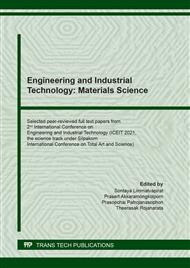p.123
p.129
p.135
p.141
p.149
p.155
p.163
p.169
p.175
Effect of Calcination Time on the Microstructure and Optical Properties of (Zn0.5Cu0.5)Al2O4 Spinel Color Pigments
Abstract:
The (Zn0.5Cu0.5)Al2O4 pigments were synthesized by solid state processing with an aim to examine the kinetics of phase formation. The calcining temperature was 1100 °C with firing times of 2, 12, 24, 48 and 96 hours during which intermediate grinding was carried out. All five obtained pigment samples appeared to be single-phase as probed by XRD. However, lattice refinement revealed differences in the lattice constant which kept decreasing and reached constancy after 24 hours of firing. Such reduction in the lattice constant was associated with incorporation of smaller copper cations into the Zn-sites. FTIR spectra also supported this result as the relevant peaks still got broadened and shifted for the calcination times of less than 48 hours. Elemental analysis of the 2-hour sample showed small presence of starting precursor particles, though not detected by XRD, suggesting an incomplete reactivity at a minute scale. These structural changes were resultantly reflected by small but significant alterations in the color parameters. A higher degree of solid solution for the samples fired for longer times, as judged by lowering in the lattice constant, resulted in detectable changes in both a and b parameters. Longer calcination times yielded a brighter (higher L values) brownish tone likely due to both diminution in the averaged particle size from pulverizing and completion of solid solution. The first would be useful for good dispersion in glazes whereas the latter could be directly related to the degree of cationic substitution, confirming the expected “true” color for this specific doping level at a particular calcination temperature.
Info:
Periodical:
Pages:
149-154
Citation:
Online since:
March 2022
Keywords:
Price:
Сopyright:
© 2022 Trans Tech Publications Ltd. All Rights Reserved
Share:
Citation:


